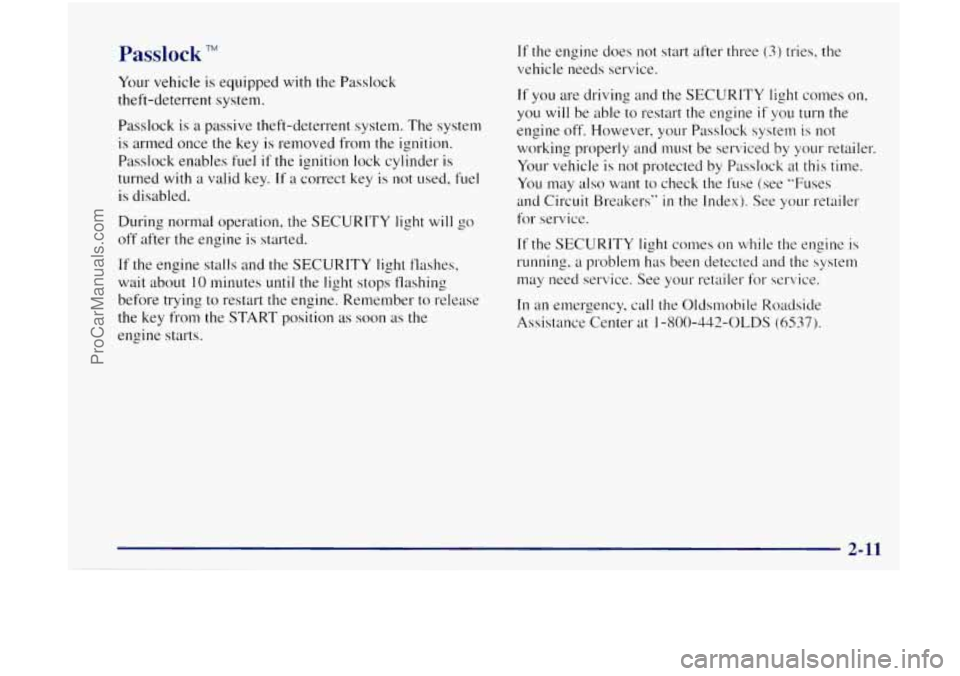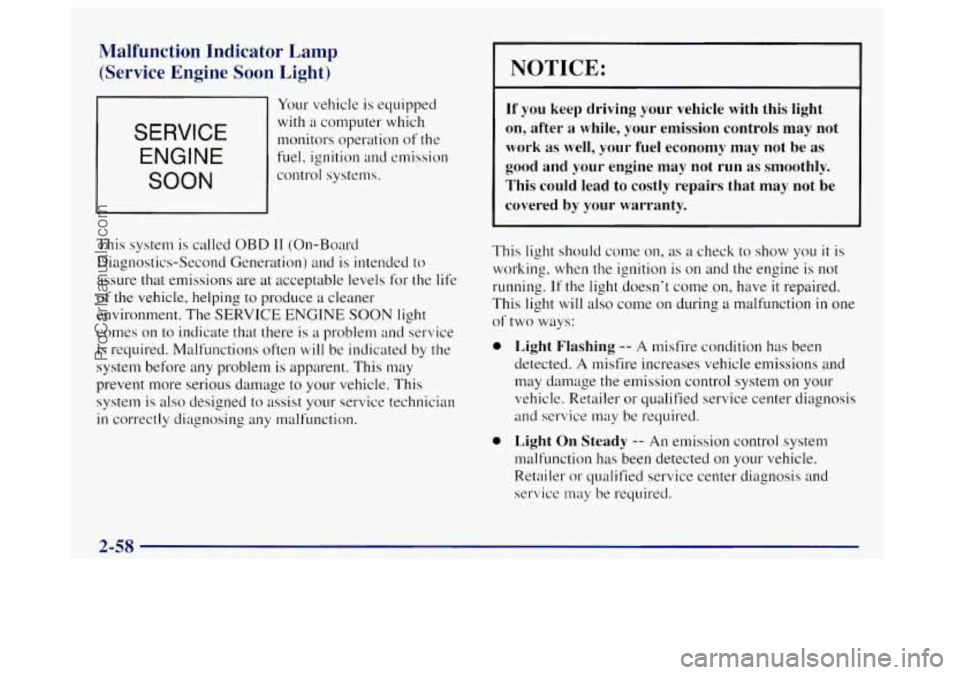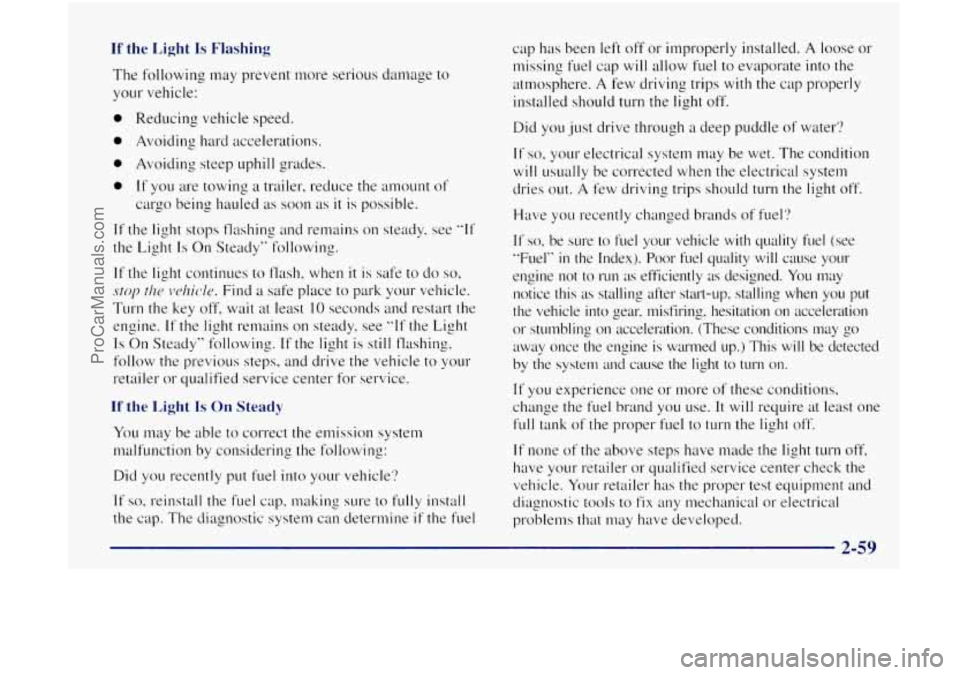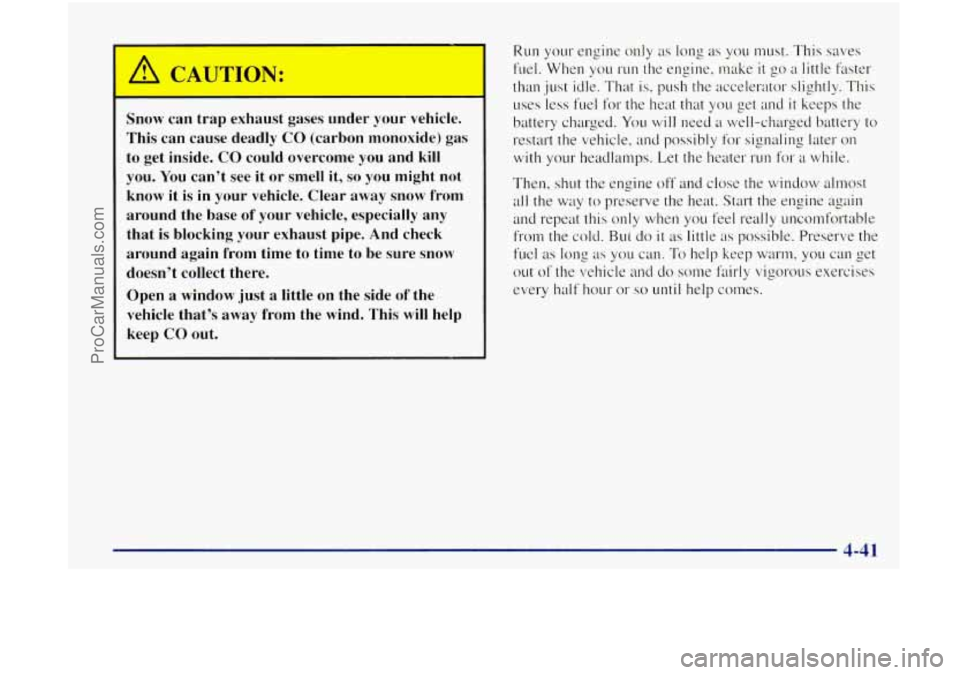check engine light OLDSMOBILE BRAVADA 1998 Owners Manual
[x] Cancel search | Manufacturer: OLDSMOBILE, Model Year: 1998, Model line: BRAVADA, Model: OLDSMOBILE BRAVADA 1998Pages: 380, PDF Size: 19.2 MB
Page 75 of 380

Passlock TM
Your vehicle is equipped with the Passlock
theft-deterrent system.
Passlock
is a passive theft-deterrent system. The system
is armed once the
key is removed from the ignition.
Passlock enables fuel if the ignition lock cylinder
is
turned with a valid key. If a correct key is not used, fuel
is disabled.
During normal operation, the SECURITY light will go
off after the engine is started.
If the engine stalls and the SECURITY light flashes,
wait about
10 minutes until the light stops flashing
before trying to restart the engine. Remember to release
the key from the START position
as soon as the
engine starts.
If the engine does not start after three (3) tries, the
vehicle needs service.
If you are driving and the SECURITY light comes on,
you will be able to restart the engine if you turn the
engine off. However, your Passlock system is not
working properly and must be serviced by your retailer.
Your vehicle is not protected by Passlock at this time.
You may
also want to check the fuse (see “Fuses
and Circuit Breakers” in the Index). See your retailer
for service.
If the SECURITY light comes on while the engine is
running, a problem has been detected and the system
may need service. See your retailer for service.
In an emergency, call the Oldsmobile Roadside
Assistance Center at
1 -800-442-OLDS (6537).
ProCarManuals.com
Page 117 of 380

Warning Lights, Gages
and Indicators
This part describes the warning lights and gages that
may be on
your vehicle. The pictures will help you
locate them.
Warning lights and gages can signal that something is
wrong before
it becomes serious enough to cause an
expensive repair
or replacement. Paying, attention to
your warning lights and gages could also save you or
others from injury.
Warning lights come
on when there may be or is a
problem with one of your vehicle’s functions.
As you
will see
in the details on the next few pages, some
warning lights come on briefly when you start the
engine just to let you know they’re working.
If you are
familiar with this section, you should not be alarmed
when this happens.
Gages can indicate when there may be or is a problem
with one
of your vehicle’s functions. Often gages and
warning lights work together to let you know when
there’s
a problem with your vehicle. When
one
of the warning lights comes on and stays on
when
you are driving, or when one of the gages shows
there may be a problem, check the section that tells you
what to do about it. Please follow
this manual’s advice.
Waiting
to do repairs can be costly -- and even
dangerous.
So please get to know your warning lights
and gages. They’re a big help.
Your vehicle also has
a driver information system that
works along with the warning lights and gages. See
“Driver Information System”
in the Index.
Safety Belt Reminder Light
When the key is turned to RUN or START, a chime will
come on for about eight seconds to remind people to
fasten their safety belts, unless the driver’s safety belt is
already buckled.
The safety belt light will
also come on and stay on
for about
20 seconds, then it
will flash for about 55
seconds. If the driver’s belt
is already buckled, neither
the chime nor the light will
come on.
2-53
ProCarManuals.com
Page 118 of 380

Air Bag Readiness Light
There is an air bag readiness light on the instrument panel,
which shows the air bag symbol. The system checks the
air bag’s electrical system for malfunctions. The light tells
you
if there is an electrical problem. The system check
includes the air bag sensors, the air bag module, the wiring
and the diagnostic module. For more information on the
air
bag system. see “Air Bag“ in the Index.
This light
will come on
when you start your engine,
and
it will flash for a few
seconds. Then the light
should go out. This means
the system
is ready.
If the air bag readiness light stays on after you start the
engine or comes on when you are driving, your air bag
system may not work properly. Have your vehicle
serviced right away.
The air bag readiness light should flash for a few
seconds when
you turn the ignition key to RUN. If the
light doesn’t come on then, have
it fixed so it will be
ready to warn you if there is a problem.
Charging System Indicator ._ Light
1 The charging system light
will come on briefly when
you
turn on the ignition,
but the engine
is not
running, as
a check to
show you
it is working.
It should go out once the engine is running. If it stays
on. or comes
on while you are driving, you may have a
problem with the charging system. It could indicate that
you have problems
with a generator drive belt, or
another electrical problem. Have
it checked right away.
Driving while this light is on could drain your battery.
If you must drive a short distance with the light on, be
certain
to turn off’ all your accessories, such as the radio
and air conditioner.
2-54
ProCarManuals.com
Page 122 of 380

Malfunction Indicator Lamp
(Service Engine Soon Light)
SERVICE
ENGINE
SOON
Your vehicle is equipped
with a computer which
monitors operation of the
fuel, ignition and emission
control systems.
NOTICE:
If you keep driving your vehicle with this light
on, after a while, your emission controls may not
work as well, your fuel economy may not be as
good and your engine may not run as smoothly.
This could lead
to costly repairs that may not be
covered by your warranty.
This system is called OBD I1 (On-Board
Diagnostics-Second Generation) and is intended to
assure that emissions are at acceptable levels for the life
of the vehicle, helping to produce a cleaner
environment. The
SERVICE ENGINE SOON light
comes
on to indicate that there is a problem and service
is required. Malfunctions often
will be indicated by the
system before
any problem is apparent. This may
prevent more serious damage to your vehicle. This
system
is also designed to assist your service technician
in correctly diagnosing any malfunction. This
light should
come on, as a check to show you it is
working. when the ignition is
on and the engine is not
running. If the light doesn’t come on, have it repaired.
This light will
also come on during a malfunction in one
of two ways:
0
0
Light Flashing -- A misfire condition has been
detected.
A misfire increases vehicle emissions and
may damage the emission control system
on your
vehicle. Retailer or qualified service center diagnosis
and service may be required.
Light On Steady -- An emission control system
malfunction has been detected on your vehicle.
Retailer or qualified service center diagnosis and
service may be required.
2-58
ProCarManuals.com
Page 123 of 380

If the Light Is Flashing
The following may prevent more serious damage to
your vehicle:
0 Reducing vehicle speed.
0 Avoiding hard accelerations.
0 Avoiding steep uphill grades.
0 If you are towing a trailer, reduce the amount of
cargo being hauled
as soon as it is possible.
If the light
stops flashing and remains on steady, see "If
the Light
Is On Steady'. following.
If the light continues to flash, when it is safe to clo so,
stop the vel?icle. Find a safe place to park your vehicle.
Turn the key off, wait at least 10 seconds and restart the
engine.
If the light remains on steady, see "If the Light
Is On Steady" following. If the light is still .flashing,
follow the previous steps, and drive the vehicle to your
retailer or qualified service center for service.
If the Light Is On Steady
YOLI may be able to correct the emission system
malfunction by considering
the following:
Did you recently
put fuel into your vehicle'?
If so, reinstall the fuel cap, making sure to fully install
the cap. The diagnostic system can determine
if the fuel cap
has been left off or improperly installed.
A loose or
missing fuel cap
will allow fuel to evaporate into the
atmosphere.
A few driving trips with the cap properly
installed should turn the light off.
Did you just drive through a deep puddle
of water?
If so, your electrical system may be wet. The condition
will usually be corrected when the electrical system
dries out. A few driving trips should
turn the light off.
Have you recently changed brands
of fuel?
If so, be s~~re to file1 your vehicle with quality fuel (see
"Fuel"
in the Index). Poor fuel quality will cause your
engine not
to run as efficiently as designed. You may
notice
this as stalling after start-up, stalling when you put
the vehicle into gear, misfiring, hesitation on acceleration
or stumbling on acceleration. (These conditions may go
away once the engine is warmed up.) This
will be detected
by the system and cause the light to turn
on.
If YOLI experience one or more of these conditions,
change the fuel brand
yo^^ use. It will require at least one
full tank of the proper fuel to turn the light off.
If none of the above steps have made the light turn off,
have your retailer or qualified service center check the
vehicle. Your retailer has the proper test equipment and
diagnostic tools
to fix any mechanical or electrical
problems that may have developed.
ProCarManuals.com
Page 125 of 380

Security Warning Light
This light will come on
briefly when you turn the
key toward
START. The
light will stay on
until the
engine starts.
Service 4WD Light
This light should come on
briefly when you turn on the
SERVICE
4WD
I ignition, as a check to show
If the light flashes, the Passlock system has entered a
tamper mode. If the vehicle fails to start, see "Passlock"
in the Index.
If the light comes on continuously while driving and
stays on, there may be a problem with the Passlock
system. Your vehicle
will not be protected by Passlock,
and you should see your retailer. The
SERVICE 4WD light
comes on to indicate that
there may be
a problem with the drive system and
service is required. Malfunctions can be indicated by the
system before any problem is apparent, which may
prevent serious damage to
the vehicle. This system is
also designed
to assist your service technician in
correctly diagnosing a malfunction.
ProCarManuals.com
Page 126 of 380

Check Gages Light
CHECK
GAGES
The CHECK GAGES light
will come on briefly when
you are starting the engine.
Gate Ajar
GATE
AJAR
This light will come on
briefly when you are
starting your engine.
If the light comes on and stays on while YOLI are driving, If it stays on, you’re liftgate is ajar. Try closing the
check your coolant temperature and engine
oil pressure liftgate again. Never drive with the liftgate even
gages
to see if they are in the warning zones.
partially open.
2-62
ProCarManuals.com
Page 159 of 380

Avoid needless heavy braking. Some people drive in
spurts -- heavy acceleration followed by heavy
braking
-- rather than keeping pace with traffic. This
is
a mistake. Your brakes may not have time to cool
between hard stops. Your brakes
will wear out much
faster
if you do a lot of heavy braking. If you keep pace
with the traffic and allow realistic following distances,
you will eliminate a lot of unnecessary braking. That
means better braking and longer brake life.
If your engine ever stops while you’re driving, brake
nol-mally but don’t
pump your brakes. If you do, the
pedal
may get harder to push down. If your engine
stops, you
will still have some power brake assist. But
you will use it when you brake. Once the power assist is
used
up, it may take longer to stop and the brake pedal
will be harder to push.
Anti-Lock Brakes (ABS)
Your vehicle has anti-lock brakes (ABS). ABS is an
advanced electronic braking system that will help
prevent
a braking skid.
When you start your engine and begin to drive away,
your anti-lock brake system will check itself. You may
hear
a momentary motor or clicking noise while this test
is going on. This is normal.
If there’s a problem with the
anti-lock brake system, this
warning light
will stay on.
See “Anti-Lock Brake
System Warning Light‘‘ in
the Index.
4-7
ProCarManuals.com
Page 193 of 380

I
A CP ""IC\:
Snow can trap exhaust gases under your vehicle.
This can cause deadly CO (carbon monoxide) gas
to get inside.
CO could overcome you and kill
you. You can't see it or smell it,
so you might not
know it is
in your vehicle. Clear away snow from
around the base of your vehicle, especially any
that is blocking your exhaust pipe. And check
around again from time to time to be sure snow
doesn't collect there.
Open
a window just a little on the side of the
vehicle that's away from the wind. This
will help
keep CO out.
Run your engine only as long as you must. This saves
fuel. When you run the engine. make it go a little faster
than just idle. That is, push the accelerator slightly. This
uses less fuel for
the heat that you get and it keeps the
battery charged. You will need
a we.11-charged battery to
restart the vehicle. and possibly
for signaling later on
with your headlamps. Let the heater run for a while.
Then, shut the engine off and
close the window almost
all the way to preserve the heat. Start the engine again
and repeat this only when you feel really uncornfortable
from the
cold. BLI~ do it as little as possible. Preserve the
fuel
as long as you can. To help keep warm, you can get
out
of the vehicle and do some fairly vigorous exercises
every half hour or
so until help comes.
ProCarManuals.com
Page 211 of 380

4. Open both hoods and locate the batteries. Find
the positive
(+) and negative (-) terminals on
each battery.
/A CAUTION:
Using a match near a battery can cause battery
gas to explode. People have been hurt doing this,
and some have been blinded. Use a flashlight if
you need more light.
Be sure the battery has enough water. You don’t
need to add water to the Delco Freedom@ battery
installed in every new
GM vehicle. But if a
battery has filler caps, be sure the right amount
of fluid is there. If it is low, add water to take care
of that first. If you don’t, explosive gas could
be present.
Battery fluid contains acid that can burn you.
Don’t get it on you.
If you accidentally get it in
your eyes or on your skin, flush the place with
water and get medical help immediately.
5. Check that the jumper cables don’t have loose or
missing insulation. If they do, you could get a shock.
The vehicles could be damaged too.
Before you connect the cables, here are some basic
things you should know. Positive
(+) will go to
positive (+) and negative (-) will go to an unpainted
metal engine part or
a body metal surface. Don’t
connect positive
(+) to negative (-) or you’ll get a
short that would damage the battery and maybe other
parts too. And don’t connect the negative
(-) to
negative
(-).
6. Connect the red positive
(+) cable to the positive
(+) terminal of the
vehicle with the
dead battery.
5-5
ProCarManuals.com